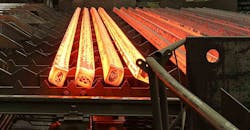The world’s primary steelmakers made a tentative move into 2018 with January tonnage rising to 139.4 million metric tons worldwide, less than 1.5% higher than the December 2017 volume and just 0.85% higher than the January 2017 total.
The data is supplied by the World Steel Assn., which tracks raw-steel output and capacity utilization by steelmakers in 64 nations, which accounts for about 99% of total raw-steel production worldwide. Raw steel is the output of basic-oxygen and electric-arc furnaces. It’s cast into semi-finished products, such as billets (seen here), blooms, and slabs.
In January, the global capacity utilization rate rose to 70.0%, just 0.7% higher than the December capacity utilization rate band just 0.2% higher than the January 2017 raw steel capacity utilization rate.
Global steel production increased more than 5% during 2017, bolstered by generally increased industrial, energy, and construction demand. Also, the prospect of tariffs restricting steel imports to the U.S. strengthened spot-steel prices, and gave hope for a longer run of industrial expansion.
These developments worked to reverse about two years of flat demand and excess supplies of steel products, which most analysts assign to the surplus output of Chinese mills. China remains by far the world’s largest steel-producing nation, but the Ministry of Industry and Information Technology there has been directing a long-term consolidation of ownership and elimination of “outdated” capacity, in order to control prices and supply. In early January, MITT reported that the nation had met its goal of reducing installed capacity by 50 million metric tons/year during 2017, and phased out 120 million metric tons of outdated capacity.
Also, the Ministry predicted it would meet its 2020 goal of phasing out 150 million metric tons/year of capacity this year (2018.) "We will strictly forbid any new steel capacity to be launched...and make sure all outdated steel capacity is eliminated and prevented from reopening," MIIT stipulated.
In January, Chinese steelmakers produced an estimated 67.58 million metric tons of raw steel, 0.07% less than in December and 0.9% less than during January 2017.
Japanese steelmakers produced 9.03 million metric tons of raw steel, 3.54% more than during December and 0.3% more than during January 2017.
India’s steelmakers increased their January output to 9.03 million metric tons, up 2.64% from the previous month and 2.47% more than the year-earlier total.
South Korea’s industry produced 6.12 million metric tons during January 2018, 0.02% over the December result and 2.72% more than the January 2017 figure.
In Europe, January raw-steel production rose to 14.39 million tons across 28 countries, up 8.63% over December and up 1.41% over last January’s result. The EU’s largest steelmaking nation, Germany, produced 3.7 million metric tons that month, 12.1% over the December total and 1.46% over the January 2017 total.
The Italian steel industry produced 2.02 million metric tons of raw steel in January 2018, 13.18% more than in December and 5.25% more than during January 2017.
French steelmakers produced 1.4 million metric tons of raw steel, 13.05% higher than their December output and 2.97% more than their January 2017 total.
In Spain, raw steel production increased 10.9% from December to 1.17 million metric tons in January 2018, down 1.02% from January 2017.
The Turkish steel industry’s January raw-steel output was 3.17 million metric tons, down 2.87% from December but up 7.59% from January 2017.
Russian steelmakers’ January raw-steel output was 5.7 million metric tons, down 3.88% from December and down 3.93% from January 2017.
In the Ukraine, the January raw-steel output of 2.1 million metric tons represents a 1.94% rise from December and a 0.14% decline from January 2017.
Brazilian steelmakers produced 2.87 million metric tons last month, up 1.5% from December and up 1.3% from January 2017.
Finally, the U.S. steel industry produced 6.8 million metric tons (7.52 million short tons) during January 2018, 1.3% more than the December total and 2.2% less than the January 2017 total.
About the Author
Robert Brooks
Content Director
Robert Brooks has been a business-to-business reporter, writer, editor, and columnist for more than 20 years, specializing in the primary metal and basic manufacturing industries.

